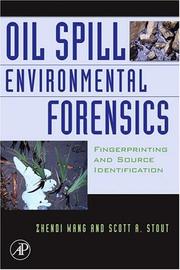| Listing 1 - 5 of 5 |
Sort by
|

ISBN: 0128096594 1280746920 9786610746927 0080467733 0123695236 0128039027 9780080467733 9780123695239 9780128039021 9780128096598 9780128038321 0128038322 9780128096598 Year: 2016 Publisher: London : Academic Press,
Abstract | Keywords | Export | Availability | Bookmark
 Loading...
Loading...Choose an application
- Reference Manager
- EndNote
- RefWorks (Direct export to RefWorks)
Oil Spill Environmental Forensics provides a complete view of the various forensic techniques used to identify the source of an oil spill into the environment. The forensic procedures described within represent various methods from scientists throughout the world. The authors explore which analytical and interpretative techniques are best suited for a particular oil spill project. This handy reference also explores the use of these techniques in actual environmental oil spills. Famous incidents discussed include the Exxon Valdez incident in 1989 and the Guanabara Bay, Brazil 2000. The
Oil spills --- Environmental forensics. --- Pollution --- Environmental aspects. --- Measurement. --- Environmental forensics --- Environmental monitoring --- Chemistry, Forensic --- Environmental chemistry --- Environmental law --- Measurement --- Environmental chemistry. --- Chemistry, Environmental --- Chemistry --- Ecology --- Handbooks and manuals.
Book
ISBN: 0128044357 0128044349 9780128044353 9780128044346 9780128044346 Year: 2018 Publisher: Cambridge, Massachusetts : Elsevier,
Abstract | Keywords | Export | Availability | Bookmark
 Loading...
Loading...Choose an application
- Reference Manager
- EndNote
- RefWorks (Direct export to RefWorks)
This book presents aspects of environmental forensics in relation to "real-world" oil spill case studies and addresses releases of crude oil, natural gas/methane, automotive gasoline and other petroleum fuels, lubricants, vegetable oils, paraffin waxes, bitumen, manufactured gas plant residues, and urban runoff, and the challenges and long-term effects each brings. Also includes new analytical and chemical data processing and interpretation methods.
Environmental forensics. --- Oil spills --- Environmental aspects. --- Chemistry, Forensic --- Environmental chemistry --- Environmental law --- Pollution --- Measurement --- Environmental chemistry. --- Measurement.
Digital
ISBN: 9780128039021 0128039027 0128096594 9780128096598 Year: 2016 Publisher: London Academic Press
Abstract | Keywords | Export | Availability | Bookmark
 Loading...
Loading...Choose an application
- Reference Manager
- EndNote
- RefWorks (Direct export to RefWorks)
Standard Handbook Oil Spill Environmental Forensics: Fingerprinting and Source Identification, Second Edition, provides users with the latest information on the tools and methods that have become popular over the past ten years. The book presents practitioners with the latest environmental forensics techniques and best practices for quickly identifying the sources of spills, how to form an effective response, and how to determine liability. This second edition represents a complete overhaul of the existing chapters, and includes 13 new chapters on methods and applications, such as emerging application of PAHi isomers in oil spill forensics, development and application of computerized oil spill identification (COSI), and fingerprinting of oil in biological and passive sampling devices.
Digital
ISBN: 9780128044353 0128044357 0128044349 Year: 2018 Publisher: Oxford, United Kingdom Butterworth-Heinemann
Abstract | Keywords | Export | Availability | Bookmark
 Loading...
Loading...Choose an application
- Reference Manager
- EndNote
- RefWorks (Direct export to RefWorks)
Oil Spill Environmental Forensics Case Studies includes 34 chapters that serve to present various aspects of environmental forensics in relation to "real-worldïÅư oil spill case studies from around the globe.ïÅưïÅư Authors representing academic, government, and private researcher groups from 14 countries bring a diverse and global perspective to this volume. Oil Spill Environmental Forensics Case Studies addresses releases of natural gas/methane, automotive gasoline and other petroleum fuels, lubricants, vegetable oils, paraffin waxes, bitumen, ïÅư manufactured gas plant residues, urban runoff, and, of course, crude oil, the latter ranging from light Bakken shale oil to heavy Canadian oil sands oil.ïÅưïÅư New challenges surrounding forensic investigations of stray gas in the shallow subsurface, volatiles in air, dissolved chemicals in water (including passive samplers), and biological tissues associated with oil spills are included, as are the effects and long-term oil weathering, long-term monitoring in urbanized and non-urbanized environments, fate and transport, forensic historical research, new analytical and chemical data processing and interpretation methods.ïÅưïÅư.
Digital
ISBN: 9780080467733 0080467733 Year: 2007 Publisher: Boston, MA Elsevier/Academic Press
Abstract | Keywords | Export | Availability | Bookmark
 Loading...
Loading...Choose an application
- Reference Manager
- EndNote
- RefWorks (Direct export to RefWorks)
Oil Spill Environmental Forensics provides a complete view of the various forensic techniques used to identify the source of an oil spill into the environment. The forensic procedures described within represent various methods from scientists throughout the world. The authors explore which analytical and interpretative techniques are best suited for a particular oil spill project. This handy reference also explores the use of these techniques in actual environmental oil spills. Famous incidents discussed include the Exxon Valdez incident in 1989 and the Guanabara Bay, Brazil 2000. The authors chronicle both the successes and failures of the techniques used for each of these events. Dr. Zhendi Wang is a senior research scientist and Head of Oil Spill Research of Environment Canada, working in the oil and toxic chemical spill research field. He has authored over 270 academic publications and won a number of national and international scientific honors and awards. Dr. Wang is a member of American Chemical Society (ACS), the Canadian Society for Chemistry (CSC), and the International Society of Environmental Forensics (ISEF). *International experts show readers the forensic techniques used in oil spill investigations *Provides the theoretical basis and practical applications for investigative techniques *Contains numerous case studies demonstrating proven techniques.
| Listing 1 - 5 of 5 |
Sort by
|

 Search
Search Feedback
Feedback About UniCat
About UniCat  Help
Help News
News